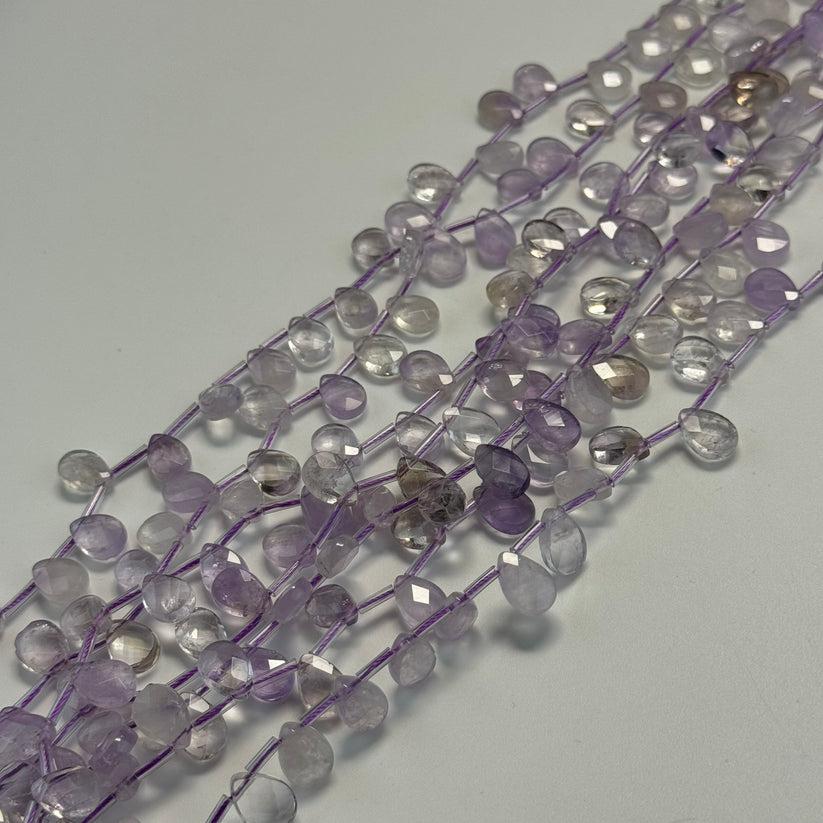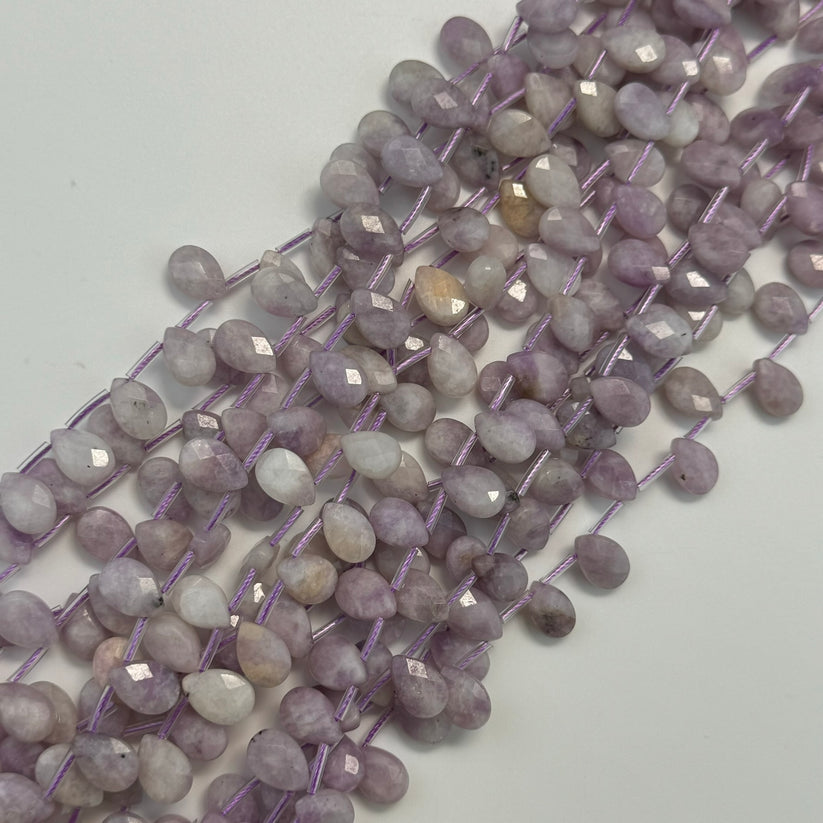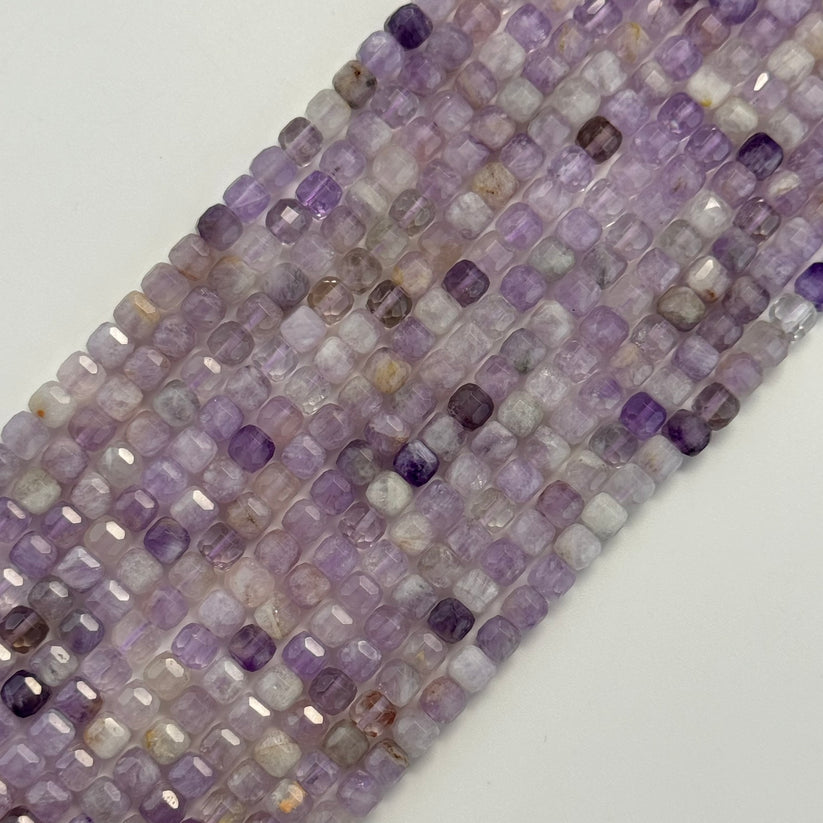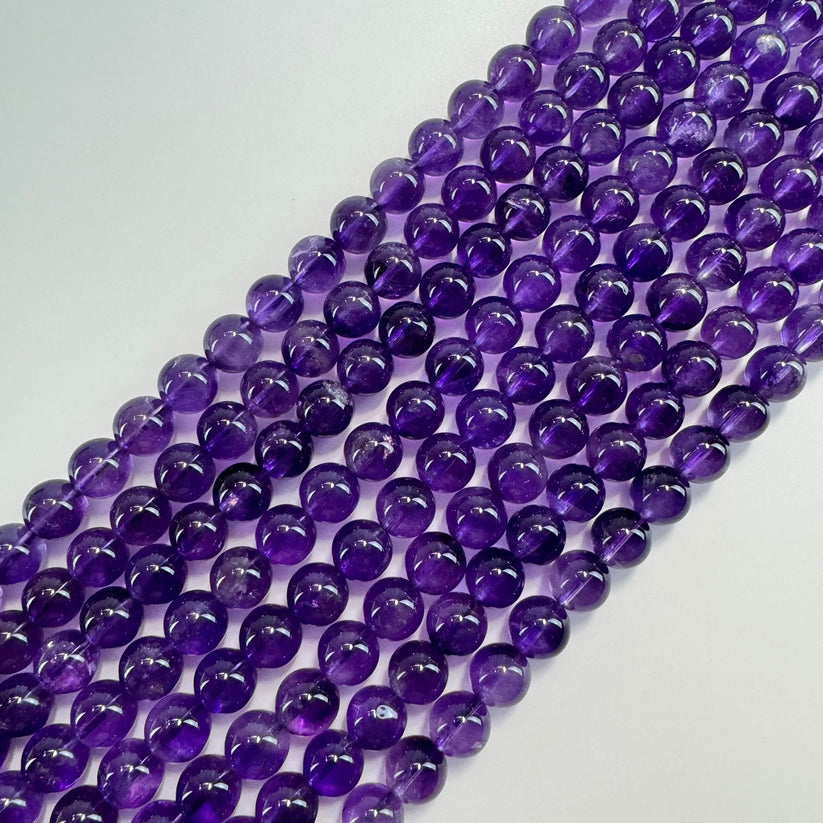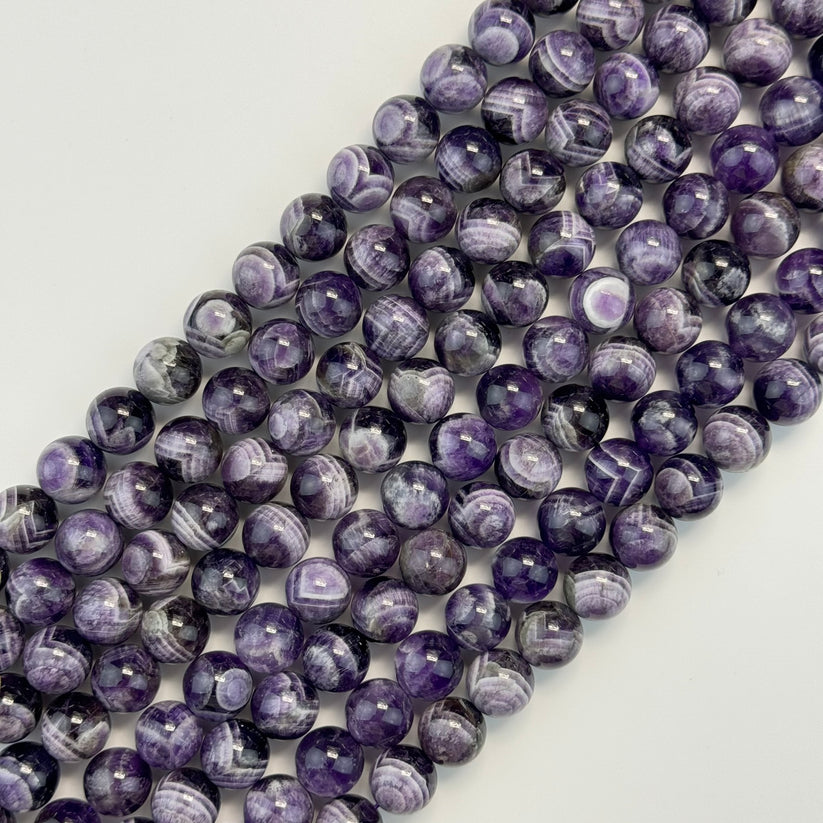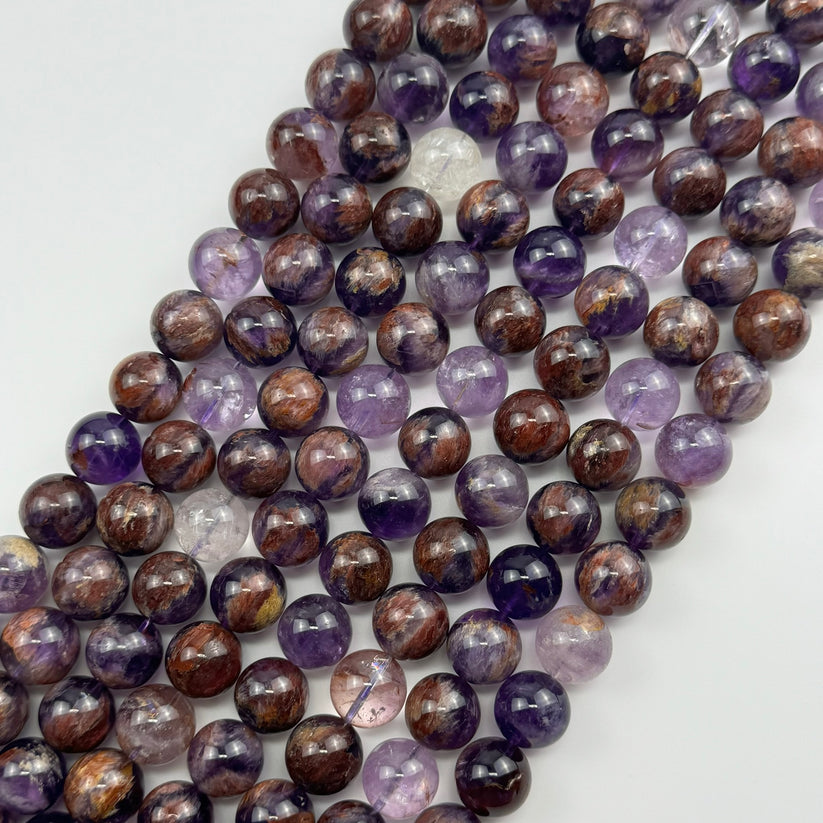
How to Professionally Make Your Amethyst Ring Using Amethyst Beads
Share
Creating a professional-looking amethyst ring requires skill, precision, and an understanding of the gemstone's unique properties. Amethyst, with its vibrant purple hues and remarkable clarity, is a popular choice for jewelry making. One of the most effective ways to craft a beautiful and high-quality amethyst ring is by incorporating amethyst beads into the design. Whether you are an experienced jeweler or a beginner, this guide will help you understand the process of using amethyst beads to make your amethyst ring stand out.
Choosing the Right Amethyst Beads
The first step in creating your amethyst ring is to choose the right amethyst beads. Amethyst beads come in a variety of shapes, sizes, and finishes, making them ideal for different jewelry designs. Some of the most common types of amethyst beads used in rings include round beads, faceted beads, and smooth polished beads. It's important to select beads that complement your design style and fit well with the ring's setting. For a more professional look, opt for high-quality beads that have been handpicked and verified, ensuring that each bead has consistent color and clarity.
Key Factors to Consider When Selecting Amethyst Beads:
-
Size and Shape: Larger beads may be used as the centerpiece, while smaller beads can accentuate the design.
-
Color: Amethyst beads are typically purple, but varying shades can add depth and uniqueness to your ring.
-
Finish: Choose from polished, faceted, or matte finishes, depending on the type of design you want to achieve.
Amethyst Color
Amethyst, known for its beautiful range of purple hues, is a versatile gemstone cherished in jewelry making. While the deep purple shades are the most commonly recognized, amethyst comes in various colors, each with unique appeal. In this article, we will explore the different colors of amethyst, including Light Lavender, Lavender, Medium Purple, Dark Purple, Violet, Deep Violet, Purple-Blue, Green Amethyst (Prasiolite), and Bi-Color Amethyst, helping you understand the full spectrum of this fascinating gemstone.
Light Lavender
Light Lavender amethyst features pale purple tones that give it a soft, serene appearance. This light and airy color adds a gentle, calming effect, making it a perfect choice for subtle jewelry pieces. Its light hues are ideal for creating delicate rings, necklaces, and earrings, especially for those who prefer a softer and more refined aesthetic. Light Lavender is often paired with metals like silver or rose gold to enhance its gentle beauty.
Lavender
Lavender amethyst is a slightly deeper shade of purple than light lavender, often with a hint of pink. This color is known for its romantic and dreamy qualities, making it a popular choice for those seeking a more feminine and elegant design. The soft purple hue of Lavender amethyst adds a refined touch to jewelry, and it pairs well with other gemstones such as rose quartz or diamonds for a luxurious look.
Medium Purple
Medium Purple amethyst offers a balanced and vibrant purple tone that is neither too light nor too dark. This shade of amethyst is often the most sought after because it embodies the classic color of amethyst while still maintaining its subtlety. Medium Purple is versatile and can be used in various jewelry designs, including statement pieces and everyday wear. Its rich purple hue complements a wide range of metal settings and other gemstones, making it a timeless choice for many designs.
Dark Purple
Dark Purple amethyst is known for its deep, intense color that conveys a sense of sophistication and strength. This shade of amethyst is perfect for creating bold, dramatic statement pieces that make a lasting impression. Dark Purple amethyst is often paired with diamonds or white gold to create a striking contrast, adding luxury and depth to any design. Its rich and powerful appearance makes it a great choice for evening wear or special occasions.
Violet
Violet amethyst displays a beautiful, vivid purple hue with blue undertones, giving it a bright and lively appearance. This shade of amethyst offers a balance between the darker, richer tones of purple and the lighter, more pastel shades. Violet amethyst is a stunning choice for those looking for a gemstone that stands out but isn't as deep as Dark Purple. It pairs well with contrasting gemstones, such as citrine or aquamarine, creating a striking color combination.
Deep Violet
Deep Violet amethyst is one of the most intense and sought-after shades of amethyst, often described as the pinnacle of the gemstone's vibrant color range. With its rich and saturated purple tones, Deep Violet amethyst is associated with power and luxury. This dark, regal hue makes it perfect for creating high-impact jewelry pieces, such as engagement rings or bold statement necklaces. The deep color of Deep Violet amethyst is often enhanced with diamond accents or set in platinum for a timeless and luxurious look.
Purple-Blue
Purple-Blue amethyst combines the best of both purple and blue hues, offering a cool, calming tone that is both unique and striking. This color variation gives the gemstone a mystical, otherworldly quality, making it an excellent choice for those looking for something different. Purple-Blue amethyst pairs beautifully with lighter gemstones like aquamarine or topaz, and it works well in contemporary or avant-garde jewelry designs. Its cool tones give it a versatile edge, allowing it to blend seamlessly with both modern and classic styles.
Green Amethyst (Prasiolite)
Green Amethyst, also known as Prasiolite, is a unique and refreshing variation of amethyst. Unlike the traditional purple hues, Green Amethyst features soft green tones that range from pale mint to deeper olive greens. This color is the result of heat treatment applied to natural amethyst, transforming it into a beautiful green gem. Green Amethyst has become increasingly popular in recent years due to its sophisticated and calming look. It is often used in rings, earrings, and necklaces, and pairs well with silver, white gold, and platinum for a serene, natural aesthetic.
Bi-Color Amethyst
Bi-Color Amethyst is a stunning variation that displays two distinct colors within the same gemstone. Typically, Bi-Color Amethyst features a combination of deep purple and lighter hues, such as lavender or even green, creating a striking contrast within the stone. This unique color variation makes Bi-Color Amethyst a sought-after gemstone for those looking for something truly one-of-a-kind. The interplay of colors in Bi-Color Amethyst makes it an excellent choice for statement pieces, including rings and pendants, where the beauty of both colors can be showcased together.
Amethyst is one of the most beloved gemstones in the world, known for its vibrant purple hues and spiritual significance. While amethyst is found in various locations worldwide, African amethyst has gained considerable attention for its striking beauty and distinct characteristics. In this article, we will explore what makes African amethyst unique, its origin, and how it compares to other varieties of amethyst.
Don't Forget the African Amethyst
What is African Amethyst?
African amethyst refers to amethyst gemstones that are mined primarily in Africa, specifically in countries such as Zambia and South Africa. These regions are known for producing some of the highest quality amethyst, thanks to the rich mineral deposits and ideal geological conditions for amethyst formation. African amethyst often features vibrant, deep purple hues, with some stones displaying lighter lavender or even bi-color variations that blend purple with other colors, such as green or blue.
One of the standout features of African amethyst is its clarity and overall appearance. African amethysts are known for their high transparency and excellent crystal structure, making them highly prized for use in fine jewelry. Their rich colors, combined with a naturally flawless finish, make African amethyst an attractive choice for collectors and jewelers alike.
Characteristics of African Amethyst
-
Color: African amethyst typically exhibits rich, intense purple hues, ranging from medium to deep purple. Some stones may even display a slight red or blue undertone, enhancing their vibrancy and overall appeal.
-
Clarity: Known for its excellent clarity, African amethyst tends to have fewer inclusions than amethyst found in other regions, which contributes to its brilliance and transparency.
-
Size: African amethysts are often found in larger crystal sizes, making them suitable for both large statement pieces and more intricate designs.
-
Durability: Like other varieties of amethyst, African amethyst is relatively durable, with a hardness of 7 on the Mohs scale, making it suitable for daily wear in rings, necklaces, bracelets, and earrings.
The Unique Appeal of African Amethyst
African amethyst stands out in the jewelry world due to its distinctive coloration and superior quality. Many jewelers seek out African amethyst because of its deep, saturated purple tones, which are highly sought after by collectors and those looking to create luxurious, eye-catching jewelry. The intense color of African amethyst makes it an ideal centerpiece for both traditional and contemporary designs, often set in rings, necklaces, and earrings to create a bold statement.
Additionally, the clarity and size of African amethyst make it ideal for those seeking larger gemstones, whether for custom jewelry pieces or investment-quality stones. The unique beauty and depth of African amethyst ensure that each stone has its own character, making it a valuable addition to any jewelry collection.
Where to Find African Amethyst
Choose Chevron Amethyst For Your Ring
What is Chevron Amethyst?
Chevron amethyst, also known as baton amethyst or dogtooth amethyst, is a variety of amethyst that features a distinctive banded pattern of purple and white or clear quartz. The chevron pattern, which resembles a "V" or zigzag shape, is created when amethyst crystals grow in layers with alternating colors of amethyst and clear or white quartz. The result is a beautiful striped or chevron-like appearance, making it a unique and eye-catching form of amethyst.
The chevron pattern in Chevron amethyst can range from light lavender to deep purple, with the white or clear quartz bands adding a striking contrast. These patterns make Chevron amethyst particularly appealing to those who appreciate distinctive and one-of-a-kind gemstones.
Characteristics of Chevron Amethyst
-
Color: Chevron amethyst features a combination of purple amethyst and clear or white quartz bands, creating a striped or chevron-like pattern. The amethyst color can range from pale lavender to deep violet, while the white or clear quartz bands provide a clean, contrasting look.
-
Clarity: Chevron amethyst generally has excellent clarity, with few inclusions visible in the stone. The striking pattern enhances the gemstone's overall appeal, making it ideal for use in jewelry.
-
Durability: Like traditional amethyst, Chevron amethyst is durable, with a hardness of 7 on the Mohs scale, making it suitable for use in rings, necklaces, bracelets, and other types of jewelry.
-
Formation: The chevron pattern is a result of the way the amethyst crystals form in layers over time. The alternating layers of purple amethyst and clear quartz create a natural, intricate design that is both visually appealing and unique.
Where is Chevron Amethyst Found?
Chevron amethyst is primarily found in Brazil, although it can also be found in smaller quantities in other regions such as the United States and South Africa. Brazil is known for producing high-quality Chevron amethyst with distinct, vibrant patterns and rich purple hues. The country's rich deposits of amethyst have made it a hub for amethyst mining, and Chevron amethyst is one of the most sought-after varieties due to its striking appearance.
Why is Chevron Amethyst Unique?
What makes Chevron amethyst truly unique is its combination of beauty and metaphysical properties. The distinct chevron pattern, with its alternating layers of purple amethyst and clear quartz, creates a gemstone that is both visually stunning and energetically powerful. Amethyst is known for its calming and healing properties, and the presence of clear quartz enhances these qualities by amplifying the energy of the amethyst.
The Chevron amethyst is often used in meditation and healing practices due to its ability to bring balance and clarity. It is believed to promote emotional healing, relieve stress, and provide protection against negative energies. The stone is also thought to enhance spiritual awareness and intuition, making it a popular choice for those seeking to deepen their connection with their inner selves.
Metaphysical Properties of Chevron Amethyst
In addition to its visual appeal, Chevron amethyst is known for its powerful metaphysical properties. Like traditional amethyst, Chevron amethyst is believed to promote calmness, mental clarity, and emotional healing. However, the chevron pattern is thought to amplify these qualities, helping individuals access a deeper level of spiritual awareness and healing.
Chevron amethyst is also said to have protective qualities, shielding its wearer from negative energy and promoting positive emotional growth. It is often used in meditation to enhance focus, clarity, and intuition, making it a popular choice for those who seek to strengthen their spiritual practices.
Garden Amethyst
Garden amethyst is a captivating variety of amethyst that features intricate inclusions resembling a garden or landscape within the stone. These inclusions, often made up of mineral formations like chlorite, hematite, or other natural elements, give garden amethyst its distinctive appearance. The result is a gemstone that combines the deep, rich purple hues of amethyst with the unique, organic patterns created by these natural inclusions, making each stone one-of-a-kind.
The unique "garden" effect within garden amethyst is what makes it so appealing to collectors and jewelry makers. The patterns resemble a miniature landscape, with wisps of green, brown, and gray mingling with the traditional purple of amethyst. These patterns are often subtle, adding depth and texture to the gemstone, making it perfect for those who want a gemstone that is both beautiful and visually interesting. Garden amethyst is often used in pendants, rings, and earrings, where the striking patterns can be prominently displayed.
Metaphysically, garden amethyst is believed to enhance healing and growth. The natural inclusions are thought to bring grounding energy, promoting emotional stability and spiritual growth. Garden amethyst is often used in meditation and energy healing practices for its calming effects and its ability to connect its wearer with the earth's energy. Its unique appearance, combined with its spiritual properties, makes garden amethyst a cherished choice for those seeking a distinctive and meaningful gemstone.
Next Step: Preparing Your Materials and Tools
To create a professional amethyst ring, you'll need a few essential materials and tools:
-
Amethyst Beads: Choose beads that will form the main structure of your ring.
-
Ring Band: Select a band that suits your style, whether it be gold, silver, or another metal.
-
Jewelry Wire or Beading Thread: This will help you secure the beads in place on the ring.
-
Jewelry Glue or Epoxy: For securing the beads to the ring band.
-
Bead Crimping Tools: To secure the wire or thread.
Step-by-Step Guide to Making Your Amethyst Ring
Step 1: Design Your Ring
Before starting, decide on the design of your amethyst ring. Are you planning to create a simple bead-focused design, or do you want to include additional elements like diamonds or metal accents? Sketch your design to have a clear vision of how the finished product will look.
Step 2: Cut the Jewelry Wire or Thread
Cut a piece of jewelry wire or beading thread to a length that will wrap around the ring band. Leave a bit of extra length to allow for knotting or securing the wire at the ends.
Step 3: Begin Beading
Carefully thread your amethyst beads onto the wire, starting from one end and working towards the other. You can choose to create a continuous strand of beads or design a pattern. Ensure the beads are evenly spaced for a professional and symmetrical look.
Step 4: Attach the Beads to the Ring Band
Once the beads are threaded onto the wire or thread, wrap the beaded strand around the ring band. Secure both ends of the wire, either by tying a knot or using crimp beads. If using jewelry glue or epoxy, apply a small amount to secure the beads in place, allowing time for it to set.
Step 5: Final Adjustments
After securing the beads, inspect the ring to ensure everything is secure and aligned. Adjust the positioning of the beads if necessary to create a balanced and uniform look.
